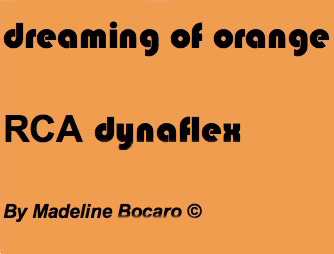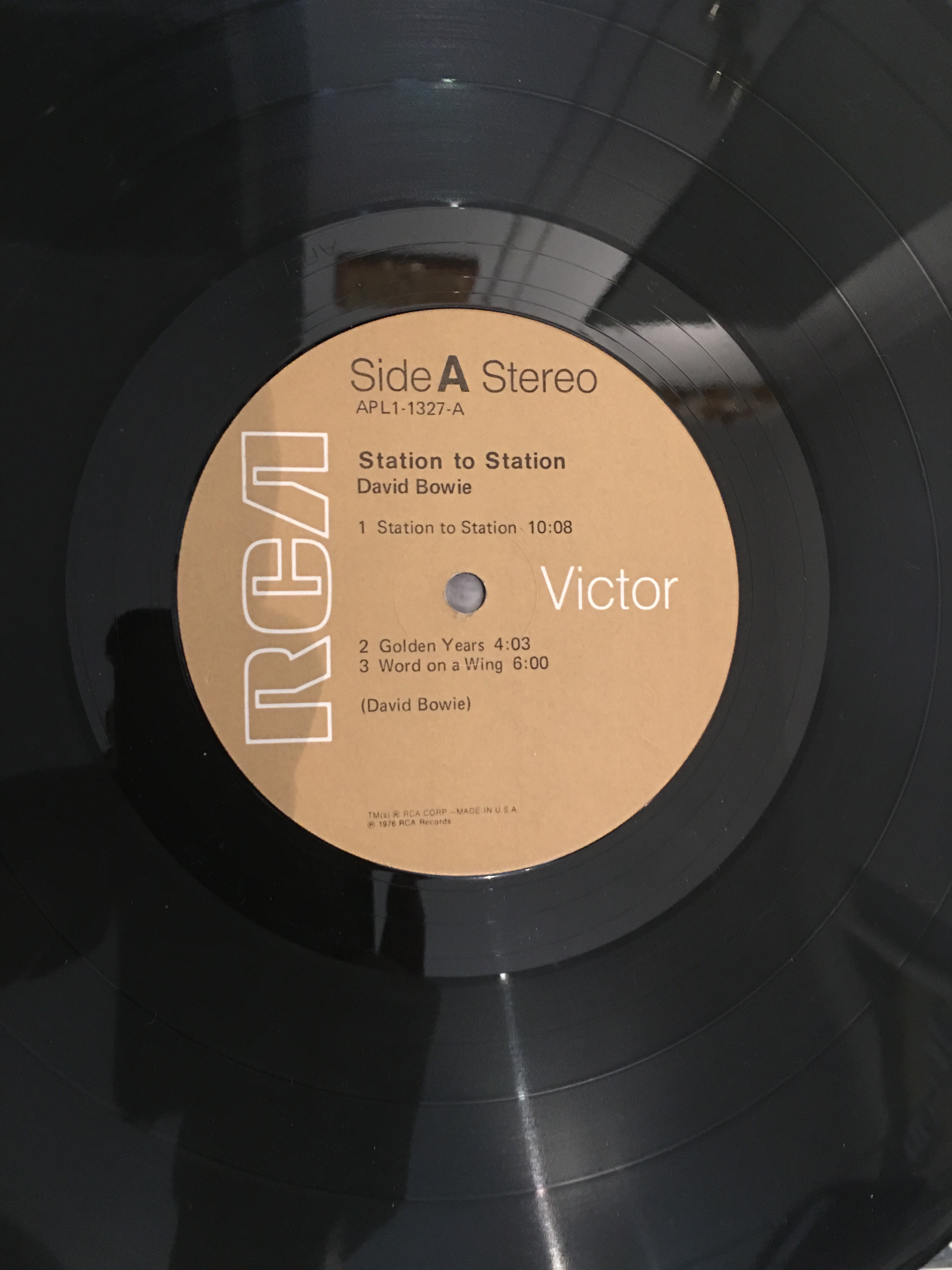By Madeline Bocaro
© Madeline Bocaro, 2019. No part of this site may be reproduced or re-blogged in whole or in part in any manner without permission of the copyright owner.

There is a persistent blissful memory from my teenage years that still brings me great joy. I sometimes have recurring dreams about it. Even while awake and closing my eyes, I can still imagine the sunny orange label spinning in a whirl on my turntable – the original label of RCA’s dynaflex albums.
My favorite 1970s records by David Bowie, Lou Reed and Mick Ronson were pressed on dynaflex vinyl. They sounded wondrously different than every other album I owned – crisp and shimmering with a heavenly clarity. Therefore, my ears are accustomed to and forever tuned in to the radiant sound of this shiny, quiet and pure vinyl – to which (supposedly superior) recordings on thick vinyl can’t compare.
Due to an oil shortage affecting vinyl cost and production in England (from 1969 through the late 1970s) record labels – whose rosters included the hottest bands at the time – were concerned that there would not be enough vinyl on which to press their new offerings quickly enough. These artists, many of whom have since become legendary, would sell records so quickly that a delay in pressing or release could lose millions of dollars. Several pressing plants were already recycling old records using reground vinyl from melted down records, which created in more noise than virgin vinyl. Unfortunately, they would often recycle bits of the paper label which failed to peel off.
In late 1969 RCA introduced dynaflex. Instead of compromising vinyl quality, the label concocted a formula using inexpensive materials which required much less vinyl and was more pure – closer to virgin vinyl in quality. RCA’s new discs were only 1/4 the weight of a record of normal thickness. dynaflexrecords are much thinner than other records, hence the wafer-thin sheet of plastic was so flexible that it would waver and make whooshing noises if you flopped it back and forth. The record was so light weight that it felt as though the album sleeve was empty. If you have never held one it is difficult to convey how extremely pliant they are.
The flexible vinyl was more durable for shipping. Thinner records didn’t break or crack as easily as thick ones. Unfortunately, the nature of thin albums could cause them to warp even before you got them onto your turntable – especially when shrink-wrapped. Remarkably this did not happen too often, as many dynaflex discs have survived the test of time and are favored by some collectors. Some say that if you put a dynaflex record under a black light, each one has a unique marbled / streaked pattern? (not all, but some).
Debates ensued about dynaflex sound quality, with equal arguments for compromised sound and superior fidelity. How could good sound possibly come from a flimsy album that actually used less vinyl? Well, somehow it did! Some felt that the bass was diminished and the treble too sharp, but most fans are still raving about how wonderful these records still sound.
The sleeve of Lou Reed’s self-titled first solo album extolls the virtues of RCA’s vinyl on its inner sleeve.
The RCA record you are holding in your hand is a
dynaflex
Record.
“It’s thinner than any other record you have ever owned.
It is also superior in many ways to any other you have ever owned.
It is freer of imperfections – ticks, pops and blisters.
It is much less susceptible to warpage.
And, it’s life will be far longer than conventional records.
It is the record of tomorrow, yours today.
RCA Records
As with Quadraphonic discs some collectors love the sound and consider dynaflex vinyl desirable. However, others refused to buy albums from the 70s if they were pressed on the ‘dreaded’ material. In my opinion, it is a stroke of luck that these vintage legendary records were pressed this way.
The RCA label became orange in late 1968 (LSP 4000-4460s) and records were pressed on stiff non-flexible vinyl. From 1971 through 1976 (LSP 4460 -1039) the same orange label was used, but ‘dynaflex’ was printed on the thinner discs.
David Bowie’s original RCA albums from are on the orange dynaflex label. Space Oddity and The Man Who Sold the World were first issued on Mercury before being reissued on RCA. While they may be rare and more expensive, original Mercury pressings were not dynaflex, nor were all original Bowie UK pressings through Lodger (1979) which also had orange RCA labels.
Bowie’s album Space Oddity was his first dynaflex album in 1969. Hunky Dory followed. The intimate acoustic songs and the punchy rockers on these two albums finally set Bowie on his proper path to fame after several false starts in other genres. David’s double-tracked vocals sounded like he was right there with us in our room.
In the summer of 1972 The Rise and Fall of Ziggy Stardust and The Spiders from Mars became one of England’s fastest selling albums. It sounds better on dynaflex – superior to any other vinyl or CD issue. Perhaps this is because it was our first experience of the album, but the clarity and crispness are undeniable. One of the most beloved guitar solos in rock history soars in this format – Mick Ronson shines on ‘Moonage Daydream’. His iconic ’68 Les Paul Custom sings whether it’s vibrating with fuzz, resonating with a warm timbre, feeding back with wah, or on a tone bender. The emotional intimacy of Bowie’s voice and the clarity of Woody Woodmansey’s drums is incredible.

Also see:
Moonage Daydreaming – Mick Ronson’s Ziggy Guitar
https://madelinex.com/2011/07/18/moonage-daydreaming/
Fortunately, Bowie was able to get his American idol Lou Reed signed to RCA, and also Mick Ronson’s two solo albums were pressed on dynaflex. Ronson’s Slaughter on 10th Avenue shimmers in all its jazzy/glam glory – especially his Annette Peacock covers. Mick’s razor-sharp guitar complements the gorgeous keyboard excursions and crisp drum sounds.
Lou Reed’s album Transformer (1972), a portrait of New York City’s underground clique of Warhol superstars – benefits from the resonating clarity of dynaflex – especially due to Mick Ronson’s meticulous and extraordinary production, and also his orchestration of stringed instruments. The intimacy of Lou’s vocals is key as well. The warm resonance and vibrating strings of Herbie Flowers’ stand-up bass on ‘Walk on the Wild Side’ along with quiet violin strings and sexy sax run at the end, give the track a cinematic feel – like Sensurround! The song sounds so smooth that it was assimilated on the radio, blending in as a mainstream track and becoming a classic. On both ‘Satellite of Love’ and ‘Perfect Day’, melodic keyboards and strings arranged by Ronson are gloriously uplifting, countering the melancholy of Lou’s subtle vocals. Bowie’s high-pitched backing vocals are stunningly clear. Lou himself was awed by the results of this collaboration. I wonder what Lou thought of dynaflex vinyl, as he was later into developing Binaural live sound.
Also see my story, Lou Reed – Transformed
https://madelinex.com/2018/05/16/lou-reed-transformed/
The album which benefits from the dynaflex format most of all is Lou Reed’s follow-up, Berlin (1973). Instead of using the same successful formula of Transformer – perhaps in an act of deliberate career sabotage – Lou chose Alice Cooper’s producer Bob Ezrin to orchestrate his new weird drama. We become ensconced in the ambiance of this chilling tragic masterpiece, as Lou intimately unravels Berlin‘s dreadful story of decadence. It sounds as if the piano is in our room – the clinking wine glasses during the heroine (on heroin) Caroline’s birthday party ring out. We can feel the chill of Alaska and see the shimmer of breaking glass as she ‘put her wrist through the window pane‘ in ‘The Bed’. The chilling ghostly apparitions in ‘Sad Song’ appear before us. Lou takes us to Germany (although he’s never been there himself). We can actually feel his presence as he reads the story to us from his own book.
See my story about Lou Reed’s Berlin album performed live in Brooklyn
Lou Reed – The Berlin Wall of Sound
https://madelinex.com/2006/12/22/lou-reed-the-berlin-wall-of-sound/
Bowie also rescued two more of his favorite groups in 1972, both of whom were about to implode; Mott The Hoople and Iggy Pop & The Stooges. However, with Bowie’s help these bands (Iggy as a solo act at first) were signed to Columbia Records and not to RCA. I wonder how their albums (Mott’s All the Young Dudes and The Stooges’ Raw Power) would have sounded with the dynaflex treatment! These albums sound exceedingly sharp as they are – particularly Mott’s version of Lou Reed’s “Sweet Jane”. I think that Raw Power especially (with Bowie’s trebly production) would have sounded so extremely raw that that there would be a race to see which shattered first, the vinyl or our eardrums!
Bowie’s following albums Aladdin Sane and Pin Ups (1973) have the same wonderfully slick sound – perfectly Glam! Mike Garson’s keyboards tinkle like shards of breaking glass on Aladdin Sane. I once asked Mick Ronson about this. He said that they spent many months mixing the albums, but he wasn’t aware of the effects of dynaflex.
Diamond Dogs and David Live (both in 1974) were also dynaflex records.
Between mid to late 1974 and January-February 1975 RCA singles had a light grey label. The tint varied before they settled upon tan. This was also when they phased out dynaflexand thickened the vinyl gram count (which was thicker than pre-dynaflex).
From 1975 through 1976 some RCA labels were still orange, but gradually they became light brown/pale gold. The reissue labels look the same, but they just say ‘Bowie’, omitting ‘David’. Bowie’s Young Americans was first issued on the RCA orange label but was quickly reissued on the tan label. Sometime in 1976 the RCA label became black again with Nipper (RCA’s dog with gramophone mascot/logo) located in the upper right. Some black labels still carried the dynaflex trademark even though the records were pressed on thicker vinyl. Low, “Heroes”, Stage and Lodger all have black labels. The disc for “Heroes” is much thicker than the others.
Station to Station (1976) was the first tan RCA Bowie album to not have an orange label equivalent. Second pressings of earlier albums with tan labels were made in 1976.
Although the label for Low was black – the flaming sunset background of the album’s cover and the early orange RCA labels influenced the color scheme in the branding of the David Bowie Is museum exhibition which originated at the V&A in 2013 and travelled the world for five years.
RCA discontinued dynaflex in 1980.

***
Note:
dynaflex is not to be confused with Flexi-discs such as Mainman’s promotional Mick Ronson flexi for his album Slaughter on 10thAvenue and those that would come on the back of cereal boxes like The Archies’ ‘Sugar Sugar’.
Prior to Dynaflex, RCA introduced, Dynagroove in 1963 – a controversial and unpopular mastering technology for vinyl. Not many Pop/Rock records were released in this format.
The process used analog computers to pre-distort and dynamically equalize the audio signal used to produce master discs. The intent was to boost bass on quiet passages and reduce distortion for low-fi sound systems. This was to compensate for the poor performance of cheap phonographs and turntables with a conical shaped stylus.
Dynagroove records sounded worse when played on high end systems. The pre-distortion was audible on a Dynagroove record played with an elliptical-shaped stylus. As the 1960s progressed, high quality playback became the norm. This made Dynagroove obsolete by 1970, and RCA phased out the technique.
http://en.m.wikipedia.org/wiki/Dynagroove#/search
© Madeline Bocaro 2019. No part of the materials available through madelinex.com may be copied, photocopied, reproduced, re-blogged, translated or reduced to any electronic medium or machine-readable form, in whole or in part, without prior written consent Madeline Bocaro. Any other reproduction in any form without the permission of Madeline Bocaro is prohibited. All materials contained on this site are protected by United States copyright law and may not be reproduced, distributed, transmitted, displayed, published or broadcast without prior written permission of Madeline Bocaro.
***
Also see my related stories:
Ziggy and our Teenage Dream
(Growing up as an American Bowie fan)
https://madelinex.com/2006/12/16/ziggy-and-our-teenage-dream/
Bowie and our Teenage Daydream
(My tribute to Bowie, written after his passing in 2016)
https://madelinex.com/2016/01/24/bowie-and-our-teenage-daydream/
Rock N’ Roll Suicide
Back To the Future – Diamond Dogs





A short list of albums pressed on RCA’s dynaflex:
Not all records with ‘dynaflex’ printed on the label are actual dynaflex pressings although it was printed on the labels for years after they stopped making the ultra-thin pressings.
Brian Auger’s Oblivion Express: Closer to It
David Bowie: Space Oddity/ The Man Who Sold the World/ Hunky Dory / The Rise and Fall of Ziggy Stardust and The Spiders From Mars/ Aladdin Sane/ Pin Ups/ Diamond Dogs/ Young Americans – tan label/ Station To Station– tan label / ChangesOneBowie compliation – tan label / Low / Lodger
Cass Elliot: The Road is No Place for a Lady
RCA Classical Red Seal LPs
Skeeter Davis
John Denver: Poems Prayers and Promises/ Back Home Again
Ducks Deluxe
Jose Feliciano
Dizzy Gillespie
The Guess Who: American Woman / The Best of The Guess Who 1971
Jefferson Airplane: Volunteers
Waylon Jennings
The Kinks: Everybody’s in Show Biz, Muswell Hillbillies
The Main Ingredient
Henry Mancini: Mancini Generation LP
Motown LPs pressed for them by RCA:
Marvin Gaye: What’s Going On/ Maybe Tomorrow
The Jackson 5: Greatest Hits
Harry Nilsson: Nilsson Schmilsson / A Little Touch Of Schmilsson In The Night/ Pussycats (with John Lennon)/ Pandemonium Shadow Show
Elvis Presley 1970s LPS: Elvis at Madison Square Garden / Elvis Country / Promised Land 1975 / Love Letters From Elvis
Lou Reed: Lou Reed / Transformer/ Berlin/ Sally Can’t Dance/ Rock N’ Roll Animal
Pure Prairie League: Bustin’ Out
Mick Ronson: Slaughter on 10th Avenue/ Play Don’t Worry – tan label
Tomita: Entire catalog
Verdi’s Aida: 1969 ‘Victrola’ reissue (recorded in the mid-50s).
The Youngbloods: Elephant Mountain
RCA – “This Is” series in the ’70’s
Orange Sunshine
My Playlist category
About A Song
https://madelinex.com/category/about-a-song/
Eat to the Beat
Main Menu:











Extraordinary post! This is all part of the big R’N’R picture that the masses need to know about. I love to read great essays like this that stick a wrench in the wheel of boring and redundant audiophile commentary. This should be taught at universities! – JEE
Glam great David Werner’s ‘Whizz Kid” was a Dynaflex record. Hard to find a nice clean copy these days.
I love this. Absolutely fascinating. I’ve seen the Dynaflex logo for years and never knew what it referred to. I always felt RCA LPs had great sound. I had black label reissues of Lust For Life and The idiot that you could practically roll up into a tube they were so flexible – would they be Dynaflex, I wonder? They were ’80s pressings, I’d imagine, with the great big ‘PRODUCED BY DAVID BOWIE’ sticker on The Idiot. (Coincidentally – there was a nasty rasping sound about a couple of minutes into Lust For Life – I thought my copy was damaged but I’ve noticed the same sound on other copies). Part of my education in the finer things was the fortuitous inheritance of older siblings abandoned record collection – including a green label Ziggy (price code YY, if memory serves), Scary Monsters, Heroes, Lodger, Italian Grey Label Diamond Dogs (someone walked off with it when I was deejaying), and Station To Station, whose label I picture as orange, but I don’t have it handy to check. Later, now long gone record shop and record fairs furnished ultra cheap copies of Aladdin, Hunky, Low, Pinups, etc. My apologies, I’m rambling … but it was magical – laying on the bed on a summer’s day, curtains drawn but with flecks of sunlight bleeding through like fiery jewels, distant sound of kids playing – and total immersion in the worlds Bowie conjured on those records. I’ve been to meditation classes – good, but only a fraction of what the youthful imagination could do. I loved this article, I love your blog, wonderful.
Thanks so much – so happy you liked my dynaflex story and my blog!